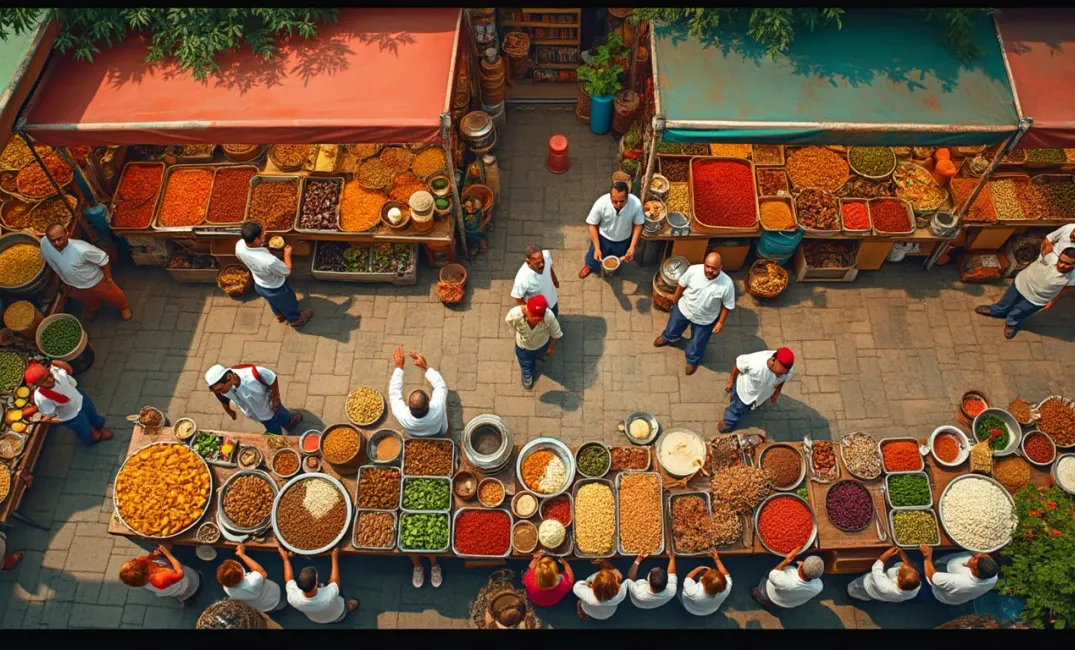A World on a Plate
Food, an essential part of human existence, transcends mere nourishment; it is a language that speaks of history, culture, identity, and innovation. As humanity has evolved, culinary traditions have mirrored societal transformations, reflecting the ingenious adaptation of resources, philosophies of diet, and the art of hospitality. Each dish tells a story—the journey of migratory peoples, gestures of cultural exchanges, adaptations to climatic demands, and the evolution of taste. In this entry, we shall explore how culinary practices have captured the myriad dimensions of human experience, connecting people across epochs and borders.
"Let food be thy medicine and medicine be thy food." — Hippocrates
The Ancestral Hearth: From Gathering to Gastronomy
The Origin of Culinary Practices
- Foraging and Gathering: In humanity's earliest days, food was obtained through foraging, hunting, and gathering. This nomadic lifestyle integrally shaped diets, with variables like climate and geography dictating available resources. Foraging not only nourished the body but also fostered intuitive knowledge about nature's offerings.
- The Birth of Agriculture: The Neolithic Revolution, around 10,000 BCE, marked a profound shift, as communities transitioned from foraging to farming. Cultivating grains like wheat and rice enabled settled communities, giving rise to surplus and sustenance for growing populations. This era introduced new methods of food processing and storage, paving the way for social stratification and complex societies.
- Cooking and Techniques: The advent of cooking facilitated the consumption of a wider range of foods and led to the development of diverse culinary techniques and tools. Fire not only provided warmth and safety but allowed humans to transform raw ingredients into varied textures and flavors, marking a pivotal moment in human dietary evolution.
Regional Cuisines: A Blend of Terrain and Tradition
- Diverse Ecosystems and Diets: As human communities spread across continents, distinct ecosystems gave rise to varied diets. Indigenous peoples adapted to local resources, crafting culinary practices from the bounties of their landscapes—Pacific Islanders perfected fishing techniques, while nomadic tribes optimized livestock herding.
- Culinary Syncretism: Throughout history, trade routes like the Silk Road facilitated culinary exchanges, enriching regional diets with spices, grains, and flavors from afar. These dynamic interactions fostered syncretism, exemplified by dishes like curries and stews that meld diverse influences into a harmonious blend.
Culinary Traditions: A Reflection of Identity and Belief
Cultural Significance of Food
- Festivals and Feasts: Food plays a ceremonial role in festivals and life events, symbolizing abundance, gratitude, and communal solidarity. Rituals such as harvest festivals, Thanksgiving, and Diwali feasts celebrate bounties with elaborate meals, offering a taste of cultural heritage and social unity.
- Religion and Dietary Laws: Religious beliefs have steered dietary practices across societies, with food taboos and prescriptions reflecting spiritual traditions—Hinduism advocates vegetarianism rooted in ahimsa (non-violence), while kosher and halal laws govern dietary habits in Judaism and Islam, respectively. Such traditions reinforce identity and offer ethical pathways to consumption.
The Philosophy of Cuisine
- Culinary Arts as Expression: Cooking is an artistic endeavor, where imagination and skill transform humble ingredients into masterpieces. Chefs and home cooks alike experiment with flavors, pushing culinary boundaries to create experiences that please the palate and elevate eating to an art form.
- Health and Nutrition: Culinary practices reflect shifts in understanding health and well-being, from ancient healing foods to contemporary dietary revolutions. Food philosophies like Ayurveda emphasize balance and harmony in meals, while modern movements advocate organic, plant-based, and high-nutrient diets for sustainable living.
Migration and Fusion: The Global Culinary Exchange
Diaspora and Culinary Evolution
- Migration's Culinary Impact: Global migrations have historically introduced new foods and culinary innovations. Immigrants bring indigenous recipes, adapt them to new environments and availabilities, whilst influencing local cooking styles. As diverse communities mesh, a rich tapestry of fusion cuisine emerges, exemplified by dishes like Creole jambalaya and British chicken tikka masala.
- Culinary Diplomacy: Food fosters connections as an ambassador of cultural diplomacy. Through the universal language of a shared meal, culinary diplomacy advances cross-cultural understanding, invites collaboration, and promotes peace. Culinary festivals and exchanges allow national cuisines to shine on the world stage, sparking interest and admiration across diverse audiences.
Technology and Modern Innovation
- Industrial Food Revolution: The Industrial Revolution brought about mass production and global distribution, changing how food was grown, processed, and consumed. While facilitating access to diverse foods, it also led to challenges such as food safety concerns and loss of traditional practices.
- Food Science and Sustainability: In recent decades, developments in food science introduced bioengineering, farm-to-table concepts, and sustainable sourcing practices. Innovations in alternative proteins and circular farming reflect humanity's commitment to environmentally conscious, ethical choices amidst global challenges.
Culinary Frontiers: New Explorations and Traditions
Gastronomy Beyond Earth
- Space Nutrition: As humans step into extraterrestrial realms, the need for sustainable nutrition solutions becomes paramount. Astronauts rely on science-driven food innovations to meet their nutritional needs in space, with visionaries exploring new culinary traditions that might flourish in lunar and Martian colonies.
- Cultural Preservation in Space: In the efforts to establish off-Earth settlements, preserving and celebrating Earth-bound culinary diversity will link settlers to ancestral roots and foster cultural continuity in the interstellar frontier.
Nourishing Human Connection
- Food as Community Builder: The act of sharing meals has long been a catalyst for human connection. In an increasingly digital world, initiatives that prioritize communal dining and culinary storytelling reinforce social bonds and foster unity, blurring divides and nurturing empathy across cultures.
- Harnessing Culinary Narratives: Beyond feeding the body, meals have nourished ideas, dreams, and revolutions. A cultural artifact, each dish tells tales of migration, adaptation, exploration, and resilience, offering a lens into the human legacy and an inspiration for our unfolding journey.
Conclusion: The Human Plate—An Ode to Unity and Diversity
The rich tapestry of global culinary traditions reflects humanity's collective creativity, adaptability, and endless pursuit of flavor. Food acts as both identity and dialogue, intertwining stories of discovery, survival, and celebration—mirrors of broader human experiences across time and space.
As we journey into uncharted domains, let the essence of shared meals inspire us to unite across boundaries, preserving the cultural kaleidoscope that enriches our world. So long as there is a story to be told, a connection to be made, and a meal to be shared, food will remain at the heart of our human voyage—a nourishing sustenance for both body and spirit.
"One cannot think well, love well, sleep well, if one has not dined well." — Virginia Woolf
May the universal language of food continue to connect and uplift as we chart our path through the cosmos, unifying the flavors of our earthly inheritance with dreams of interstellar communion.
INNOVATION, FUSION CUISINE, CULINARY TRADITIONS, MIGRATION, CULTURE, SUSTAINABILITY, GLOBAL CUISINES, FOOD HISTORY

